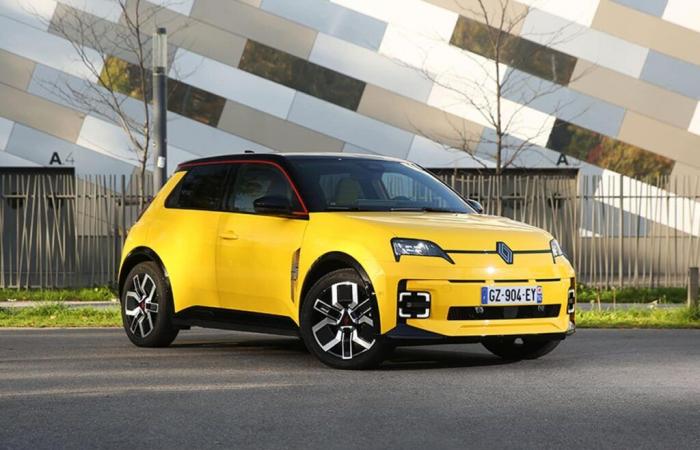After its international presentation, the Renault 5 e-Tech made a detour to our bases to undergo the Supertest.
Almost four years after the presentation of the Renault 5 Prototype, the electric city car is finally arriving on the roads. Heir to the original R5 and Super 5, it is also the replacement for the no less famous Renault Zoé. After its first test carried out in the south of France by my colleague Maxime Fontanier, the Renault 5 e-Tech is taking part in the Supertest. As a reminder, the Supertests are now enriched with new measures. We invite you to discover it, as well as our methods, which are now stricter than ever.
Also readClean Automotive Supertests: this is how our measurements work!
Presentation of the Renault 5 e-Tech
The Renault 5 displays disturbing similarities with the Renault Zoé. However, this is not the case. The newcomer is based on the AmpR Small platform, which hides the CMF B EV platform, itself derived from the CMF B on which the Clio 5 is based. A major difference with the Renault B that we found with the Zoé.
In the floor there is a battery with a gross capacity of 55 kWh, for 52 kWh of useful capacity. Values strictly identical to those of the Zoé ZE50. However, it is made up of 184 cells when the predecessor had 192 to achieve the same capacity. The battery powers a synchronous electric machine with a wound rotor, moreover derived from that of the Megane e-Tech. It can deliver a maximum of 150 hp (110 kW) for 245 Nm of torque.
In this Iconic version equipped with 18-inch rims, the Renault 5 e-Tech announces a WLT autonomy of 410 km, which is therefore equivalent to a direct consumption of 12.7 kWh/100 km. Taking into account the losses linked to alternating current charging during the approval procedure, consumption is given for 15.0 kWh/100 km. We move on to the numbers.
Additional data
- Peak power: 150 hp – 110 kW
- Net power (box P.2): 106 hp – 78 kW (-32%)
- Weight in service (box G.1): 1,449 kg
- Power-to-weight ratio (PVOM): 10.26 kg/hp
- Recharge AC : 11 kW – 4 h 15 (10-100 %)
- Recharge DC : 10 kW – 31 min. (10-80 %)
- Pneus : Continental EcoContact 6Q – 195/55 R18 – A, B, 72 dB
All our consumption measurements for the Renault 5 e-Tech
Combined range: 325 km
At the end of our mixed 10 km journey carried out in both directions, the Renault 5 e-Tech had an average consumption of 15.9 kWh/100 km. Consumption higher than its direct competitors, served by timid energy recovery on the road. Fortunately, she makes up for it in town. Ultimately, this results in a theoretical total range of 325 km.
| Route | Fast lane | Ville | Total | |
| Conso. average A/R (kWh/100 km) | 15,5 | 19,0 | 13,5 | 16,0 |
| Theoretical total range (km) | 335 | 274 | 385 | 325 |
Long distance on motorway: 224 km
On our 500 km motorway route between the outskirts of Lyon and the capital, the Renault 5 e-Tech had an average consumption of 23.2 kWh/100 km as it crossed the finish line. Which corresponds to a total range of almost 225 km, or 160 km from 80 to 10% charge. In these conditions, it does as well as a Jeep Avenger (23.0 kWh/100 km), but the Peugeot e-208 and its 250 km (20.2 kWh/100 km) retains the advantage.
Also readTest – Peugeot e-208 GT: consumption and range measured in our Supertest
Instant consumption at high speed
At 70 and 90 km/h, the Renault 5 displays averages of 11.4 and 14.5 kWh/100 km. At 110 km/h, the appetite rises to 18.6 kWh/100 km, while it takes 23.6 kWh/100 km at 130 km/h. The resulting total ranges are perfectly theoretical, but the spectrum ranges from 450 to 220 km.
| 70 km/h | 90 km/h | 110 km/h | 130 km/h | |
| Cons. average (kWh/100 km) | 11,4 | 14,5 | 18,6 | 23,6 |
| Theoretical total range (km) | 456 | 359 | 280 | 231 |
Eco-driving: 441 km
The Renault 5 e-tech has an Eco mode, which limits the power to around 80 hp in peak and the speed to 115 km/h (0-100 km/h in 15.5 s, 400 m DA in 19 .6 sec). It also automatically places the air conditioning in Eco mode which, with the same setting on the dashboard, causes an average loss of one degree on board compared to normal operation. In terms of regenerative braking, it has neither paddles nor freewheel mode, and only mode B is available to drivers. In short, very basic which does not allow for miracles: we noted a consumption of 11.8 kWh/100 km at the end of our journey. There is no doubt that the electric machine of the Peugeot e-208 GT knows how to be more sober!
All our performance measurements of the Renault 5 e-Tech
Accelerations and recovery
With 150 hp peak and a weight of 1,449 kg empty, the Renault 5 e-Tech has a weight/power ratio of 10.26 kg/hp. That's as much as a Jeep Avenger. This allows it to go 0-100 km/h in 8.0 seconds and pass the 400 m mark at its maximum speed of 150 km/h in 15.9 seconds. Slightly less alert, but without restricting power, Comfort mode requires 8.2 and 16 seconds respectively. Performance very close to a Peugeot e-208. In any case, Sport mode is a gadget here, as we noticed during our trip on the Napoleon road.
| Driving mode | 0-100 km/h | 80-120 km/h | 400 m |
| Eco | 15,48 s | – | 19,59 s |
| Comfort | 8,19 s | 5,70 s | 16,04 s |
| Sport | 8,01 s | 5,49 s | 15,94 s |
However, the Renault regains the advantage in terms of acceleration with a time of 6.2 seconds on the exercise of 80-120 km/h from a stabilized speed. The Lioness requires 8.3 s for the same exercise at the same load rate of 80%… Note the good endurance performance of the Renault 5 with 6.3 s at 20% load.
Braking and energy recovery
In terms of braking, the Renault 5 blows hot and cold. Entrusted to ventilated discs, the classic braking system, called dissipative, is up to the task. We measured a stopping distance of 62 m (3.6 s) from 130 km/h, or 22 m (2.2 s) from 80 km/h. It does better than the Mini Cooper SE, which has already gone through these workshops (article to come).
| Measure | Distance | Temps |
| 130-0 km/h | 61,8 m | 3,6 s |
| 100-0 km/h | 36,9 m | 2,8 s |
| 80-0 km/h | 22,3 m | 2,2 s |
As for regenerative braking, two modes are offered. In default mode, it takes 427 m (40 s) for the car to stop from 80 km/h. In mode B, our GPS beacon measured a distance of 167 m (16 s). In the absence of ePedal, we stopped the car with conventional braking from 10 km/h in both cases. Also, remember that this is the average of two measurements taken in both directions.
| Braking mode | Distance | Temps |
| Mode B | 167,6 m | 16,3 s |
| Rain. normal | 427,5 m | 39,5 s |
As we noticed during our various journeys, the regeneration power is not the highest with a peak of -40 kW in mode B at 80 km/h (see regeneration power curve below). This feeling was confirmed (twice!) on our route with a height difference of 600 m, where the city car only recovered 410 Wh. Which, with the 5.27 kWh consumed on the way up at a strictly identical rate, represents a rate of 8%. The Mini Cooper SE does better in this area. We'll come back to that.
Also readTest – Renault 5 electric: proud to be French!
Comfort and life on board
For the rest, the Renault 5 e-Tech has already demonstrated its level of versatility to us during a first trip via the Route Napoléon. Firm, but not uncomfortable, it is between a Peugeot e-208 and a Mini Cooper SE. With its voluntary and eye-catching front end, it makes you smile, provided you don't ask too much on greasy roads, or even in the rain.
Behind the wheel, the atmosphere appeals, as does the manufacturing quality despite some savings here and there. This is the case with door seals which allow air infiltration above the windows. Nothing unpleasant in the long run, but we wonder if the window is completely closed the first time. Proof of this is with our sound level meter readings, with 66 dB at 110 km/h and 70 dB at 130 km/h. This is what we see on board the Scenic e-Tech. Finally, in terms of habitability, it should be remembered that the bench seat is not very welcoming in terms of access to the vehicle, knee room or equipment: there is no storage compartment or USB ports. The trunk is nevertheless generous with 277 l. But the floor is placed very low behind a high threshold.
Despite an approved autonomy similar to that of its direct competitors, the Renault 5 e-Tech has slightly higher consumption. Nothing that really changes the situation since it is located at the same level as the others within around ten kilometers. Which won't change anyone's life in the real world. All that remains is to see what it does at fast charging stations and during long journeys. We'll talk about it next week!
The rest of your content after this announcement
The rest of your content after this announcement






